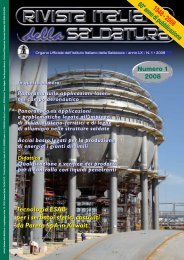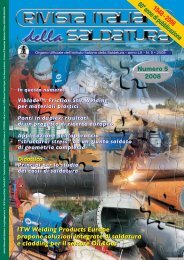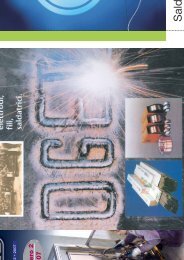Create successful ePaper yourself
Turn your PDF publications into a flip-book with our unique Google optimized e-Paper software.
E. Seib e M. Koçak - Fracture analysis of strength undermatched welds of thin-walled aluminium structures using FITNET procedure<br />
Strain hardening exponents for mismatch, N M, base, N B, and weld materials, N W, are<br />
defined as follows:<br />
σUTS denotes the ultimate tensile<br />
strengths of base (subscript B) and weld<br />
(subscript W) materials. FYM and FYB are<br />
the yield load solutions for the mismatch<br />
and base material plates, respectively.<br />
By the use of Eq. (14), the FITNET FFS<br />
procedure takes account of the interaction<br />
between base and weld metals in<br />
terms of post-yield properties of the<br />
weld joint constituents. The described<br />
procedure aims at reducing the excessive<br />
conservatism<br />
(in case of overmatching)<br />
and<br />
non-conservatism<br />
(in case of undermatching)<br />
in<br />
prediction of critical<br />
conditions for<br />
weld flaws. The<br />
present paper<br />
focuses on the<br />
validation for the<br />
safe applicability<br />
of this procedure<br />
to thin-walled<br />
highly strength<br />
undermatched Al-<br />
96 Riv. Ital. Saldatura - n. 1 - Gennaio / Febbraio <strong>2007</strong><br />
alloy welds. Contrary to the overmatched<br />
cases, there is a need for a fully<br />
validated procedure for undermatched<br />
welds.<br />
4.2 Material related input<br />
information<br />
4.2.1 Tensile properties<br />
One of the major input parameters in the<br />
FITNET FFS analysis is the yield load<br />
of the mismatched configuration.<br />
Figure 8 - Schematics of the micro-flat tensile specimen extraction from the LBW and FSW welds.<br />
(8)<br />
(9)<br />
(10)<br />
(11)<br />
(12)<br />
(13)<br />
(14)<br />
(15)<br />
(16)<br />
The yield load solution presented above<br />
contains the mismatch factor M, which<br />
in turn depends on the yield strength of<br />
the weld material. An important task is<br />
therefore the determination of the weld<br />
metal tensile properties. Two approaches<br />
will be presented in the following:<br />
tensile tests using standard flat specimens<br />
containing transverse welds and<br />
micro-flat tensile specimens.<br />
It is known that the standard flat tensile<br />
specimens produce tensile properties of<br />
the whole joint covering the interaction<br />
between base and weld areas. However,<br />
micro-flat tensile specimens enable the<br />
determination of local tensile properties.<br />
These 0.5 mm thick and 1.5 mm wide<br />
small specimens, see Figure 8, were<br />
extracted using electrical discharge<br />
machining (EDM) from different locations<br />
of the LBW and FSW joints.<br />
Figure 8 also shows the extraction technique<br />
for sheet thicknesses up to about<br />
3.0 mm. For thicker plates, specimens<br />
can also be extracted across the weld<br />
joint. This technique yields full stressstrain<br />
curves obtained from the bulk<br />
material of the region of interest. The<br />
elongation was measured at a gauge<br />
length of L 0 = 7 mm. It should be noted<br />
that micro-flat tensile specimens are<br />
made of all-weld material and thus<br />
provide the intrinsic (local) material<br />
tensile properties.<br />
The stress-strain curves are shown in<br />
Figure 9 a) along with the base material<br />
curve. The undermatching nature of the<br />
LBW and FSW joints is clearly visible.<br />
Since the TMAZ region is narrower than<br />
the width of the micro-flat tensile specimen,<br />
tensile specimens from that region<br />
also contained material of HAZ. This





